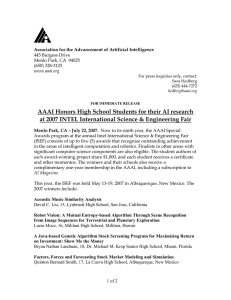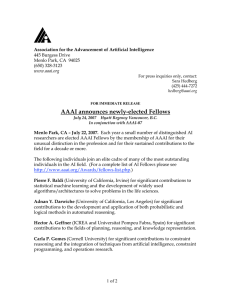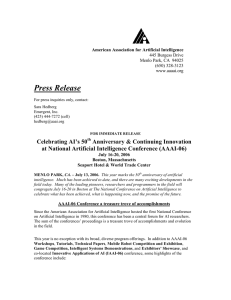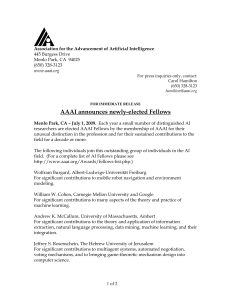Press Release Celebrating 50 Anniversary of
advertisement
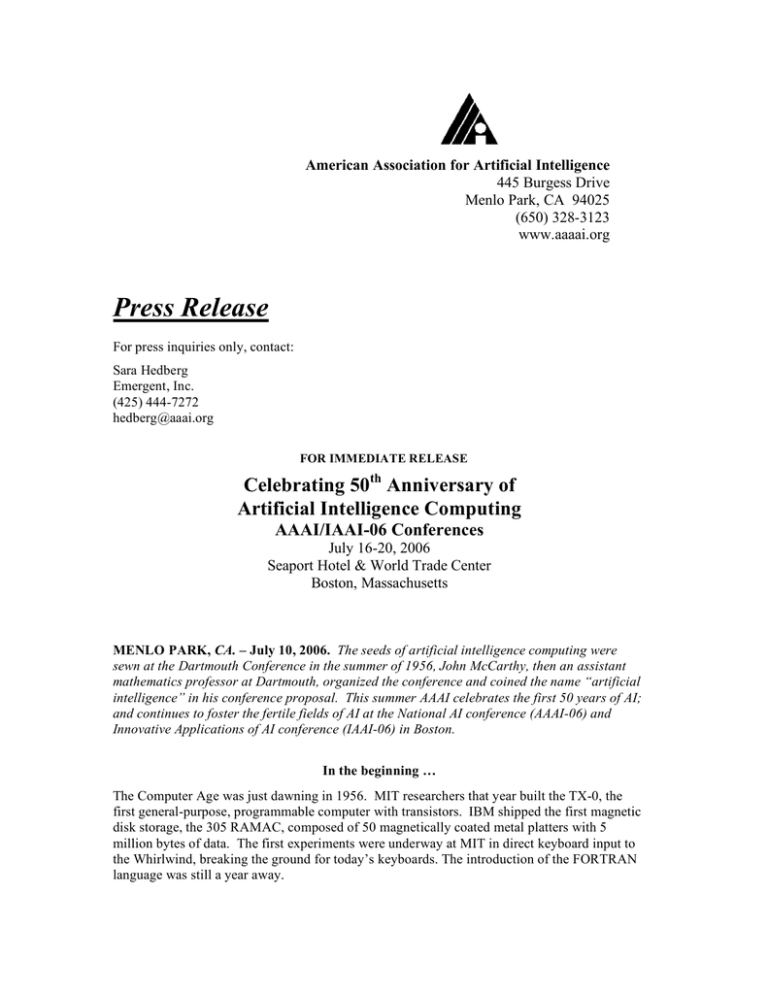
American Association for Artificial Intelligence 445 Burgess Drive Menlo Park, CA 94025 (650) 328-3123 www.aaaai.org Press Release For press inquiries only, contact: Sara Hedberg Emergent, Inc. (425) 444-7272 hedberg@aaai.org FOR IMMEDIATE RELEASE Celebrating 50th Anniversary of Artificial Intelligence Computing AAAI/IAAI-06 Conferences July 16-20, 2006 Seaport Hotel & World Trade Center Boston, Massachusetts MENLO PARK, CA. – July 10, 2006. The seeds of artificial intelligence computing were sewn at the Dartmouth Conference in the summer of 1956, John McCarthy, then an assistant mathematics professor at Dartmouth, organized the conference and coined the name “artificial intelligence” in his conference proposal. This summer AAAI celebrates the first 50 years of AI; and continues to foster the fertile fields of AI at the National AI conference (AAAI-06) and Innovative Applications of AI conference (IAAI-06) in Boston. In the beginning … The Computer Age was just dawning in 1956. MIT researchers that year built the TX-0, the first general-purpose, programmable computer with transistors. IBM shipped the first magnetic disk storage, the 305 RAMAC, composed of 50 magnetically coated metal platters with 5 million bytes of data. The first experiments were underway at MIT in direct keyboard input to the Whirlwind, breaking the ground for today’s keyboards. The introduction of the FORTRAN language was still a year away. “The summer conference, convened on the campus of Dartmouth College in Hanover, New Hampshire, brought together for the first time many of the early pioneers of cybernetics, automata and information theory, operations research, and game theory,” according to the Software History Dictionary Project of the Charles Babbage Institute. “Attendees (of the Dartmouth Conference) adopted the following slogan as a starting point for their discussion, ‘Every aspect of learning or any other feature of intelligence can in principle be so precisely described that a machine can be made to simulate it.’ This statement has essentially remained the credo of artificial intelligence research ever since.” 1 Allen Newell, Herbert Simon, and Clifford Shaw first publicly demonstrated their landmark Logic Theorist at the conference. Considered by many to be the first AI program, it was the first time a computer proved abstract statements rather than just performing specific calculations. The Logic Theorist could independently prove 32 of the 58 mathematical theorems in Bertrand Russell and Alfred North Whitehead’s Principia Mathematica. It ran on the JOHNNIAC computer, created by John von Neumann. The Dartmouth Conference attendees hypothesized (dreamed?) that much would be achieved in the field by 1970. For instance, a digital computer would become a chess grandmaster. In fact, it would take until 1997 to achieve this dream when IBM’s Deep Blue beat then reigning World Chess Champion Garry Kasparov. Other dreams from the conference, like computers understanding spoken language, are still only partially realized. AI today: ubiquitous and pervasive AI today is a very broad field encompassing a wide range of research and application endeavors from Abduction and Agents to Vision and the Web.2 Over the past 50 years there has been tremendous progress in instantiating the dreams of the Dartmouth Conference. There have been the huge and highly visible AI wins like Deep Blue, and the recent victorious completion of the DARPA Grand Challenge by a Stanford University robotic vehicle. Perhaps more important and far-reaching than the ‘big wins’ has been the steady, incremental progress of AI – from invention in the labs, to the crossover to early adopters, and finally fanning out into industry and everyday life. AI is ubiquitous. It is not always recognized how thoroughly AI is blended into the fabric of modern society – in space, on land, in water, and in cyberspace. For instance: • Most electronic gadgets and home appliances today have fuzzy logic embedded to automatically fine tune their performance. • Walk into many household superstores and you bump into displays of small robot vacuum cleaners. • The management and operations of many of the largest chain stores in the U.S. are powered in part by rule based reasoning embedded into a software suite by entrepreneur Randy Fields, husband of cookie maven Mrs. Fields, company Park City Group. • Any products you purchase that are imported by cargo ship to the U.S., travel U.S. waters more safely, efficiently and in a more environmentally sound manner due to an 1 Charles Babbage Institute, Software History Project, Dartmouth Conference of 1956, http://www.cbi.umn.edu/shp/entries/dartmouthconference.html 2 For a topic listing of a very comprehensive AI library, see AAAI’s AI Topics index http://www.aaai.org/AITopics/html/sitemap.html intelligent monitoring system deployed by NOAA (the National Oceanic and Atmospheric Administration, and Northrop Grumman.3 • For several years, NASDAQ has been using an AI-based data mining system that digs through between 8,500 and 18,000 newswire stories, approximately 1,000 quarterly and annual SEC filings from corporations, and evaluates price-volume models for 25,000 securities each day, identifying and linking “items of interest” that may warrant further investigation. The system has raised the red flag on a number of cases (including some very high profile, instantly recognizable cases) to the SEC and Justice Department for further investigation and/or prosecution. Itemizing all of the intelligent applications now in use would take volumes. Indeed, many are not known outside the towers of industry, as corporations, government agencies, and others hold such information close to the vest to protect their “secret sauce” of competitive advantage. An outstanding sampling of high-impact AI applications can be found in the 18 years of AAAI’s Innovative Applications of AI conference proceedings. They demonstrate just how ubiquitous AI has become. This body of applications will be reviewed this summer by Neil Jacobstein, CEO of Teknowledge, in his IAAI-06 invited talk, “Electrifying Knowledge Work: 362 Innovative Applications of Artificial Intelligence 1989-2006.” The Innovative Applications winners this year are a strong testimonial to the contribution AI continues to make today, such as: • IBM has saved over $100 million over the past decade with an intelligent system which verifies hardware design prior to casting. It has been used in the development of numerous IBM Power processors, i/p-series servers, Cell and Microsoft’s Xbox TM core processors and systems, and various processors of Apple computers. • General Electric has saved $44.5 million between 2000 and 2005 with an AI-based system to help the GE consumer appliances customer help desk answer customers’ question. • CombineNet (Pittsburgh, PA) created $1.8 billion of hard-dollar savings on $16 billion of sourcing from a system that augments traditional sourcing with electronic reverse auction and a quick tree search algorithm. The technical conference (AAAI-06) points the way towards emerging trends in AI research, such as the many ways that AI researchers are working to make the World Wide Web more intelligent and responsive, and the advances researchers are making in robots. The dreams and aspirations born 50 years ago are coming to fruition. # 3 # # Vafaie, Haleh and Carl Cecere, “CORMS AI: Decision Support System for Monitoring US Maritime Environment”, Proceedings of Seventeenth Conference on Innovative Applications of AI 2005, p. 1499, AAAI Press, Menlo Park, CA. About AAAI Founded in 1979, the American Association for Artificial Intelligence (www.aaai.org) is a nonprofit scientific membership society devoted to advancing the science and practice of AI. Its mission is to: (1) advance the scientific understanding of the mechanisms underlying intelligent thought and behavior, (2) facilitate their embodiment in machines, (3) serve as an information resource for research planners and the general public concerning trends in AI, and (4) offer training for the current and coming generations of AI researchers and practitioners. The Association has sponsored an annual conference, regarded as the premier gathering in the field, since 1980.


